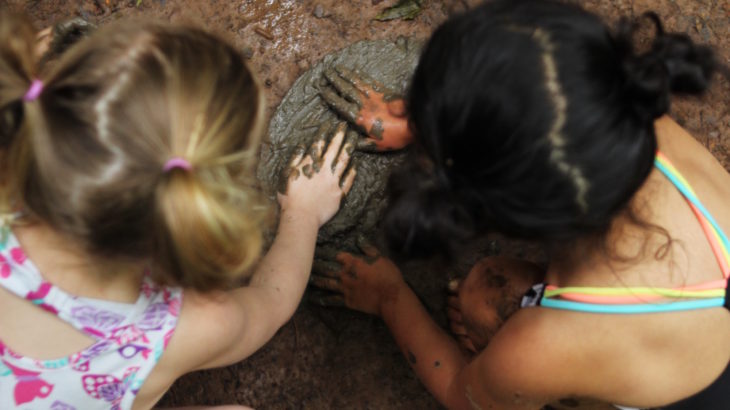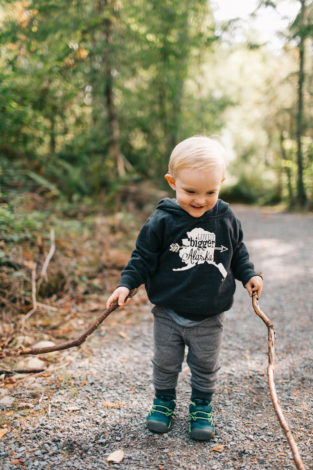Raising Trail Heroes: Teaching our Children Trail Stewardship
Having Kids Increased My Appreciation of the Outdoors
My husband and I have always been passionate about the outdoors and the environment. Our appreciation of the trails and land has become significantly greater since becoming parents. Unfortunately, the amount of excuses that we have for not practicing trail stewardship has also increased. However, we try not to let that stop us. My youngest child and I spend almost every day in the outdoors with our Hike it Baby friends, neighbors or with the rest of our family. We feel it is our responsibility as members of the outdoor community to take care of the trails and the land. It is a family goal that trail and land stewardship be a fundamental part of who we are and we want to pass that on to our kids.
Having Kids Means We get Creative About Trail Stewardship
In our home state of Washington, there are plenty of organizations that provide opportunities for adults, families with older children and teenagers to work on the trails and learn how to be land stewards. Trail stewardship activities look a little different with a 3-year-old in tow. In order to introduce our kids to the idea of trail stewardship, we do the following:
- Read books about our local and national park system, as well as ecologists and conservationists
- Study the trails we are going to hike
- Focus on Park Rangers (see Hike it Baby's Ranger Interview Series)
- Talk about trail volunteers (who we call Trail Heroes)
- Draw pictures incorporating stewardship ideas
- Be mindful about appreciating the work of others along the trail.
 Kids can help maintain trails by clearing mud off stepping stones or wood bridges While still focusing on having fun in nature, as our kids have gotten older, we have encouraged them to be active stewards. We are always brainstorming ways to incorporate stewardship into our Hike it Baby branch. I reached out to Krista Dooley, Youth Programs Director for Washington Trails Association, for some insight and advice on activities that are Hike it Baby-friendly, and she had a lot of great suggestions that are truly helpful to the trail.
Kids can help maintain trails by clearing mud off stepping stones or wood bridges While still focusing on having fun in nature, as our kids have gotten older, we have encouraged them to be active stewards. We are always brainstorming ways to incorporate stewardship into our Hike it Baby branch. I reached out to Krista Dooley, Youth Programs Director for Washington Trails Association, for some insight and advice on activities that are Hike it Baby-friendly, and she had a lot of great suggestions that are truly helpful to the trail.
Kid-Friendly Trail Stewardship Ideas
- Remove debris in between decking of puncheon bridge structures to reduce buildup and prevent slipping. (Kids enjoy using small sticks to push the debris through the spaces between the decking).
- Clear off trail signs that may have collected moss or debris over the winter/spring seasons for easier navigation.
- Throw fallen limbs or rocks on the downhill side of the trail to clear the corridor, but be careful to look for switchbacks and hikers on trails below.
- Bring along an extra bag and gloves to pick up any trash along the trail. It can be turned into a game to collect as many pieces of trash during the hike. (The winner is the clean trail queen/king of the day.)
 Even the young walkers can help move sticks and other debris off trail.
Even the young walkers can help move sticks and other debris off trail.
Kids Can Make a Difference on Trail
Obviously, land and trail stewardship looks different when babywearing parents or toddlers do it. But it is still valuable and the benefits are abundant. At home, every member of our family is a valuable part of our team and is treated with equal respect. Our children have age-appropriate responsibilities. While, I would be lying if I claimed that they never complained about it, they more often than not enjoy the pride they feel through contributing. They are more cooperative, have abundant self-confidence, are less frustrated and are happier in general. Recent research would suggest that we are not the only ones experiencing these benefits and numerous studies support the idea that children can and should contribute. The same system works on the trail and, in addition to the positive benefits listed above, it has notably increased their ability to appreciate the trails and nature, and it has also deepened their connections to the outdoors.
Be a Trail Hero
We began to make an effort to mindfully include trail and land stewardship into our lives. A couple months later my 3-year-old and I were out hiking when we came upon a small toppling stone wall along the side of the trail. I thought it was too big of a challenge. My daughter, however, stopped and began to carefully lift the rocks in her tiny hands and rebuild the wall. We worked slowly but soon the wall was finished and we continued on with other wonderful adventures that day. However, as we drove home that night and discussed our day, the thing she focused on was that she had helped fix the wall and was proud to be a “trail hero.”
Lindsey lives in Washington State with her husband, Andrew, and their two children. She has a spirit for adventure, a fierce passion for public lands and a grateful heart. When she isn't hiking or spending time outdoors with her awesome family she enjoys reading, playing the Ukulele, and eating too much chocolate.
ABOUT OUTGROWN
OutGrown is a 501(c)(3) nonprofit that works to create a world where everyone can enjoy the physical and mental benefits of spending time outside. We are focused on creating opportunities and removing barriers to access so families with babies and young children can take their first steps outside. We believe all families have the right to connect with nature, benefit from spending time outdoors and be inspired to a lifelong love of nature. Since its grassroots inception in 2013, OutGrown is a growing community of 280,000 families and over 300 volunteer Branch Ambassadors. More information on all of our programs can be found at WeAreOutGrown.org
EDITOR’S NOTE:
We hope you enjoyed reading this article from OutGrown. We’re working hard to provide our community with content and resources that inform, inspire, and entertain you.
But content is not free. It’s built on the hard work and dedication of writers, editors, and volunteers. We make an investment in developing premium content to make it easier for families with young children to connect with nature and each other. We do not ask this lightly, but if you can, please make a contribution and help us extend our reach.
Related Content




Comments